Commentary : How Should the Jesus Seminar’s Conclusions Be Viewed? : Con: Instead of asking ‘What did Jesus say?’, the Seminar should have asked ‘What is a Gospel?’
- Share via
Through the centuries observant readers as well as biblical scholars have recognized major differences (often called “contradictions”) in the Gospels of Matthew, Mark, Luke and John. These differences have always raised questions about the nature and integrity of the Gospels as witnesses to Jesus and his ministry.
During the last six years the Jesus Seminar has sought to make a public matter of the reliability of the Gospels as a source for the teachings of Jesus. After having earlier decided that some passages in the Sermon on the Mount and the Lord’s Prayer were never taught by Jesus, the Seminar most recently announced its final results on the sayings of Jesus: Only 20% are authentic.
Can we trust the Gospels? Are they reliable?
One of the oldest approaches to the problem was to harmonize the four Gospels by ignoring or explaining away the differences. Yet the very persistence of the problem over the centuries indicates the failure of this approach.
Although some differences are only apparent and can be explained, many are real and cannot be explained. Their number only increases when we compare the “teachings” of Jesus by examining the Gospels side by side. Compare, for instance, the Lord’s Prayer in Matthew 6:9-13 with Luke 11:2-4 or the Beatitudes of Matthew 5:3-6 with Luke 6:20-21. Harmonizing the Gospels just does not work.
The primary question, however, is neither the age-old issue-- “How do you explain the differences among the Gospels?”--nor is it the Jesus Seminar’s--”What did Jesus say?” The fundamental question in assessing the integrity of the Gospels is--”What is a Gospel?”
Hand someone the book Gulliver’s Travels and the reader will most likely find it to be a delightful fantasy, not unlike Alice in Wonderland. Hand it to one familiar with Jonathan Swift and the reader will recognize it to be a literary masterpiece of political satire. Understanding the author’s setting and intention affects the reader’s expectation.
Similarly, the reader needs to understand the nature and intention of the Gospels before assessing their historical value. Were the Gospels originally intended to give us a verbal snapshot or a less exact portrait of Jesus and his ministry?
Most people, including the majority of Christians, read the Gospels as though they were verbal snapshots of Jesus’ ministry that tell us precisely what Jesus did and said. Like a good snapshot, they have apparently captured once and for all an event or saying from Jesus’ life and ministry.
When we read the Gospels as verbal snapshots of Jesus, their differences and the claims of the Jesus Seminar raise serious problems. We can no longer trust what the Gospels supposedly say. If, for example, John 3:16 in red letters is not a direct quotation of Jesus’ very words (as claimed by the Jesus Seminar), then John’s Gospel becomes an unreliable witness to Jesus and his ministry. We can no longer trust what the Gospels say.
If, however, the Gospels were intended to be read as verbal portraits of Jesus and his ministry, a very different set of criteria for reliability would obtain. A portrait artist sets out to capture and portray the person rather than merely reproduce what one can see. Unlike a snapshot, the artist can select, alter, modify, rearrange, and even create to produce a portrait of a person. Some portraits bear almost a snapshot-like resemblance; others are quite abstract. The final criterion is how well it represents the person or some aspect of the person’s identity.
When we read the Gospels as verbal portraits of Jesus, the differences in his deeds and words actually belong to the details of the portrait. The details are important as they serve the portrait. The question moves from the historical accuracy of each detail (as with the snapshot approach and the Jesus Seminar) to the accuracy of the portrait as a whole. The question, therefore, is not whether John 3:16 is an authentic saying of Jesus but whether John 3:16--as a part of the portrait of the fourth Gospel--reliably depicts Jesus.
Did Jesus in his ministry declare that “God loved the world” and that he was specially “sent” by God as the “son” so that all who “believed in him” would have a new kind of “life”?
If the Gospels are verbal portraits and not verbal snapshots of Jesus, how can we know if the Gospel portraits reliably tell us who Jesus was or is? Ultimately, this is a historical question.
First, a careful study of the Gospels over the last two centuries has shown that the Gospels’ writers, writing more than a generation after Jesus’ death, made use of different sources of oral and written tradition whose subject was the work and teaching of Jesus. Second, a detailed analysis of these multiple traditions indicates that they generally support and complement rather than contradict each other regarding Jesus.
Third, this tradition shaped and developed by the early church’s preaching and teaching has its roots in Jesus’ ministry. Finally, the portraits of the four Gospels composed from these diverse traditions also complement rather than contradict each other. Consequently, we do not have four different, conflicting portraits of Jesus.
Many respected New Testament scholars have criticized the Jesus Seminar’s working assumptions and even more have criticized the method of using a majority vote to determine what Jesus actually said, especially since only a very small portion of the reported 200 scholars actually participated in the polling.
Yet the real issue lies with the assumption behind the news stories that the Gospels are snapshots. Telling the public that the Gospels are not transcripts of Jesus’ teaching (nor were ever intended to be!) becomes misleading, if one does not tell the public what the Gospels are (and were intended to be). John 3:16 may not be a direct quotation of Jesus, but it can accurately portray Jesus’ ministry.
The words of John 20:31 speak in their own way for all four Gospels: “These are written so that you may believe that Jesus is the Messiah, the son of God, and that through believing you may have life in his name.” The consistency of this portrait of the Christ in the four Gospels is hardly coincidence. May it not be that the Christ portrayed to us through the Gospels actually corresponds to the historically plausible Jesus of Galilee?
More to Read
Sign up for our Book Club newsletter
Get the latest news, events and more from the Los Angeles Times Book Club, and help us get L.A. reading and talking.
You may occasionally receive promotional content from the Los Angeles Times.









